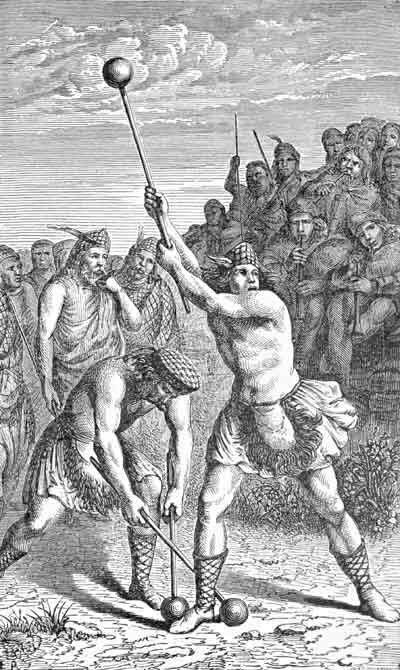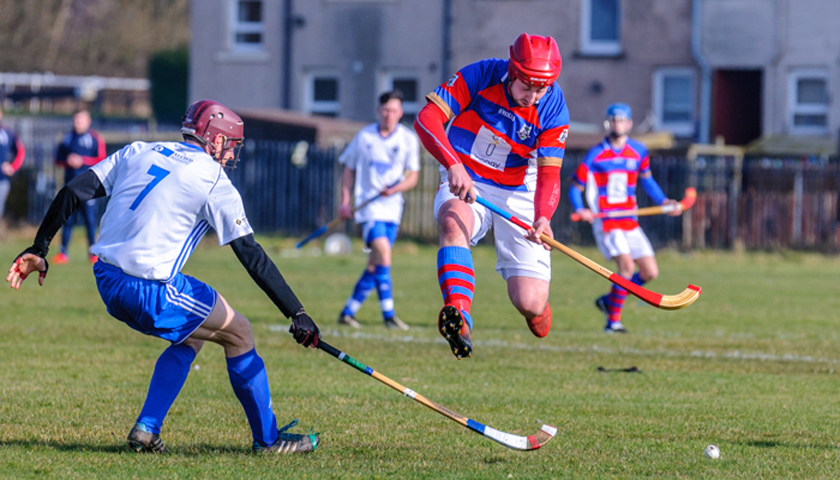Scottish SportsOne of the things all cultures seem to have in common is that they all have games. Some games are rather sedentary like monopoly or scrabble. Sports are more physical. There agreed upon rules where there are specific goals. Games are recreational activities with any number of players. There is some sort of goal that needs to be achieved. Some games like solitaire can be played by one person, whereas others, as is found in some computer online games may have huge numbers. So most sports, by this definition are games as well. Within sports any particular competition (usually between teams) is called a “game”. So we can have a baseball “game”, a football (regardless of its American or European meaning) “game”, a hockey “game” and so on. So rather than go on with a linguistic foray into games and sports, there are some that are peculiarly associated with Scotland.  When one thinks of Scotland, the first sports that come to mind are interestingly enough The Highland Games. Among the ones that commonly come to mind are the “heavy events”: the caber toss, the hammer throw, the shot put and the tug of war. Aside from the caber toss the other events were not developed in Scotland or any of the other Gaelic speaking countries. The tug of war is not particularly Scottish and is found in many countries around in the world in some form or other. The hammer toss, weight throw, stone put weight over the bar and sheaf toss are all similar events that they involve throwing objects of substantial weight. 
The hammer toss and weight throw are almost the same involving a metal ball attached to a chain which is swung by the competitor and then let fly – distance being the object. The stone put is basically the shot put with a stone, rather than a steel ball being used. There are 2 forms, one which (the Open Stone) allows the athlete to run before throwing the stone and one which (The “Braemer Stone) does not. The "Braemar Stone" makes use of a 20–26 lb (9–12 kg) stone for men and a (13–18 lb or 6–8 kg for women) In the "Open Stone" competitions a 16–22 lb (7–10 kg) stone is used for men while an 8–12 lb or 3.5–5.5 kg one is used by women). The stone must be “put” with one hand and must be resting cradled in the neck until the moment of release. The Scottish Highland Games contain two weight throwing events. In the one event the weight, 28lb or 56lb, is thrown in a similar manner to a discus. In the other event, the 56lb weight gets thrown over a bar for height. Weight over the bar or weight for height is a stone throwing event in which participants attempt to toss a 56 pound weight with a handle attached, over a horizontal bar using only one hand. The competition involves each thrower having three chances to toss the weight over the bar. After the contestants have thrown, those who have successfully cleared the bar proceed to the next round at which time the bar is raised. Another throwing event is the Sheaf toss in which a bundle of straw weighing 20 (9.1 kg) for men and 10 pounds (4.5) kg for women is used. The straw is wrapped in a burlap bag and tossed with a pitch fork. Like the “weight over the bar”, there are “rounds” of tosses with those who clear the bar going on to the next round in which the bar is raised. The caber toss is an event that is seen perhaps as a peculiarly Scottish sport. The “caber” (a word derived from the Gaelic word for “beam”) is typically made from a Larch tree and ranges anywhere from 16–20 feet (4.9–6.1 m) tall and weighs between 90–150 pounds (6.4–10.7 st; 41–68 kg) and usually somewhat narrower at one end. The object is to hold the caber in an upright position with the narrow end in the thrower’s hands and the wider end above, The person runs forward and tries to “toss” the caber in such a way that it lands on the broader end and flips over. In addition the caber should land as close as possible to a “12 o’clock” position which means it should land in a straight line to the direction of the run, The Maide-leisg ('Lazy Stick' in Scots Gaelic) is a rather odd event. It is performed by 2 people sitting on the ground. They sit in such a way that the soles of their feet are pressed together. They both grasp a stick with their hands and pull against it until one or the other is raised from the ground. Trial of strength performed by two men/people sitting on the ground with the soles of their feet pressing against each other. Thus seated, they hold a stick between their hands which they pull against each other until one of them is raised from the ground. Team sports that originated within the Gaelic speaking countries may have rules that were originally or are now peculiar to each of the countries playing. Two of these are shinty and curling Curling is a game related to shuffleboard bowls and bocce. It involves moving an object (in this case a “stone”) towards a goal. The stone in curling slides down a sheet of ice known as a “curling sheet”. The rotation of the stone causes its path to curl, hence the name. The object closest to the goal or “target” receives points and after 8 or 10 stones have been thrown. Thrown in this case is more like “slid” rather than “thrown” or “tossed”. The oldest known curling stone is one with the date of 1511 on it and was found in Dunblane when a pond was drained. Paintings from 1565 by Peter Bruegel the Elder show Flemish peasants playing curling (sans brooms) The stones themselves are made from one of two kinds of granite that some from an island off the coast of Ayrshire called Ailsa Craig, and from the Trefor Granite Quarry in Wales. The World Curling Federation requires that the stone should have the following specifications: it must weigh between 38 and 44 pounds (17.24 and 19.96 kg); it must have a circumference no greater than 36 inches (914.4 mm) and must be at least 4.5 inches (114.3 mm) in height. The sheet is to be as flat and level as possible. It measures anywhere from 146 to 150 feet (45 to 46 m) in length and 14.5 to 16.5 feet (4.4 to 5.0 m) in width. The bottom of the stone is not flat, but has a “running surface”. This is a narrow ring and is the only part that touches the ice and measures 1⁄4 to 1⁄2 inch (6.4 to 12.7 mm) wide and about 5 inches (130 mm) in diameter; The stone itself has a bulge to it that narrows to the ring at the bottom. The inside of the ring is made concave to clear the ice thus reducing the amount of friction. Probably the most noticeable aspect of the sport are the men with brooms who sweep the ice head of the sliding stone. The sweeping serves two functions – one is to move any objects from the ice that might lie in the path of the stone. The other object is to cause the surface of the ice to liquefy from the heat of the friction of the sweeping allowing the stone to move further. The 1998 Olympic Games held the first Curling games as a medal sports event. Until then it had been a demonstration sport. In February of 2002 the International Olympic Committee decided to retroactively make curling an official sport starting in 1924 and medals were awarded back to that time with the gold going to Great Britain, 2 silver medals to Sweden and the bronze to France. There are men’s curling, women’s curling and mixed doubles curling event. Since the official adoption of curling as an Olympic Sport in 1998. The major medal winner has been Canada. Possibly as a result of the decision, 2002 also saw the appearance of a film called Men With Brooms, directed by Paul Gross which deals with the sport. ShintyThis game is played with sticks and a ball. In some ways it is much like field hockey. It is likely related to another game called “bandy” the Scottish Gaelic for which translates as “ice shinty”. The game is related to Irish “hurling” which goes back at least 2.000 years. The game is played on a 140-to-170-yard-long (128 to 155 m) by 70-to-80-yard-wide (64 to 73 m) pitch, at each end of which is a “hall” or goal. The object of the game is for a team to get the ball into the “hall”. The winning team is the one that scores the most goals. Teams consist of 12 men or 10 women players. The rules for the game deal largely with the way in which the ball (and other players) may be dealt with. Players may not hit each other’s sticks but may use them for blocking and tackling. Ball playing may not use the head – even accidentally. Goal keepers cannot catch the ball, but can used the palm of their hands. The game is fast paced and considered the fastest game played on the grass. There are a number of videos on Youtube of the Scottish games and are great fun to watch. Covid19 Vaccine Tracker for ScotlandIf you want to keep informed on how covid19 is spreading in Scotland this is one useful web site. It also allows you to see how the vaccines are getting distributed in the various areas of Scotland. Just toggle between "Vaccine Tracker" and "Covid-19 Tracker". Clicking on an area or city will show you graphs over time. |
